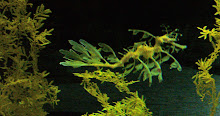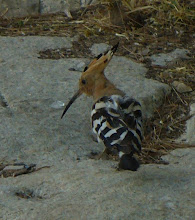Earlier this week, I completed an interview with herpetologist and rainforest explorer Dr Paul S. Hamilton of Reptile and Amphibian Ecology International (RAEI).
RAEI is a non-profit organisation that accepts volunteers and interns for scientific expeditions in the rainforests of Ecuador and runs various wildlife photography courses in the Amazon rainforest. Their website is www.reptilesandamphibians.org/ . RAEI has been in the news a lot lately because of this press release , which talks about new species they discovered on a recent trip to Ecuador. 30 new species of frog and a new snake species, to be precise.
Dr Hamilton told me about these new rain frogs and snail-eating snake that were discovered on his most recent trip to the Amazon, Ecuador's exceptional biodiversity and about RAEI's new study area- the Rio Bigal Biological Reserve- in the North West of the country.
I am happy to say that the interview is due to go on sale in the UK in Practical Reptile Keeping magazine in the next couple of days.
As usual for Practical Reptile Keeping, in the UK, you can get a copy in J. S. Sainsbury's supermarkets, W.H. Smiths and high street newsagents. International subscriptions are available from [here].
Sunday, 28 February 2010
Saturday, 27 February 2010
Link of the day- Greg du Toit photographs lions, bustards, waterbuck and zebras
Link of the day today is this article and its gallery of 11 stunning photographs of watering-hole wildlife-
http://www.thesun.co.uk/sol/homepage/news/2870439/Snapper-lies-in-wait-for-animals.html
The photographer is South African wildlife photographer Greg du Toit, who spent 3 months submerged in a watering hole to catch photographs of lioneeses drinking, managing to catch malaria, bilharzia and a number of other horrible diseases and parasties in the process...
http://www.thesun.co.uk/sol/homepage/news/2870439/Snapper-lies-in-wait-for-animals.html
The photographer is South African wildlife photographer Greg du Toit, who spent 3 months submerged in a watering hole to catch photographs of lioneeses drinking, managing to catch malaria, bilharzia and a number of other horrible diseases and parasties in the process...
Friday, 26 February 2010
Prehistoric filter-feeders- link of the day
Today's link is to this science story-
http://news.discovery.com/animals/giant-fish-filter-feeders.html
- an article by Jennifer Viegas about new research on prehistoric fish fossils. Specifically, a study by Matt Friedman, Kenshu Shimada and collegaues, reporting the discovery of giant filter-feeding fish (the size of SUVs) from the mesozoic era.
Thanks to Dolev for the tip-off.
http://news.discovery.com/animals/giant-fish-filter-feeders.html
- an article by Jennifer Viegas about new research on prehistoric fish fossils. Specifically, a study by Matt Friedman, Kenshu Shimada and collegaues, reporting the discovery of giant filter-feeding fish (the size of SUVs) from the mesozoic era.
Thanks to Dolev for the tip-off.
Thursday, 25 February 2010
Science update- new strategy for combatting AIDS spread
One of the big science news stories of the week is this-
http://uk.news.yahoo.com/21/20100222/thl-aids-could-be-beaten-in-40-years-d831572.html
- story: a proposal by South African AIDS expert Professor Brian Williams to combat the spread of HIV by mass screening and treatment of those infected with anti-retroviral drugs with the aim of preventing further spread of the virus (and the side effect of giving those treated longer life expectancies, rather than the other way around). According to the article above, it is estimated that spread of the virus could be halted by 2015 using this method and that the eventual deaths of those infected would mean that AIDS effectively died out by 2050....
http://uk.news.yahoo.com/21/20100222/thl-aids-could-be-beaten-in-40-years-d831572.html
- story: a proposal by South African AIDS expert Professor Brian Williams to combat the spread of HIV by mass screening and treatment of those infected with anti-retroviral drugs with the aim of preventing further spread of the virus (and the side effect of giving those treated longer life expectancies, rather than the other way around). According to the article above, it is estimated that spread of the virus could be halted by 2015 using this method and that the eventual deaths of those infected would mean that AIDS effectively died out by 2050....
Labels:
AIDS,
Brian Williams,
HIV,
Science update,
South Africa
Wednesday, 24 February 2010
Link of the day- Poisonous plants
Link of the day today is this article- http://news.uk.msn.com/environment/wildlife/photos.aspx?cp-documentid=152183472&ocid=ukhotmailhttp://www.blogger.com/post-create.g?blogID=5149687252890209715 on poisonous plants. It was run on 16th February on a (belated) valentine's day pretext, but is really just an excuse to talk about plant toxins...
Tuesday, 23 February 2010
Link of the day-Panda diets
Link of the day today is this popular science article by Heidi Jeter on giant pandas- what they eat and, more importantly, research on why they don't eat-
http://ezinearticles.com/?Zoo-Professional-Discovers-Dietary-Trends-in-Giant-Pandas&id=3461637
http://ezinearticles.com/?Zoo-Professional-Discovers-Dietary-Trends-in-Giant-Pandas&id=3461637
Monday, 22 February 2010
Sunday, 21 February 2010
Blog updates, logo
Welcome to the *newly enhanced* Weirdbeautiful blog - now complete with logo... There were some technical problems with updating this blog; these have now be fixed, but I had to try several different solutions first, which is why the blog has changed format 4 or 5 times over the course of today.
Link of the day- Cute and Endangered Monkeys...
Link of the day today is to this article and gallery of images of monkeys.
Sadly, as well as being very endearing and cute, they are all endangered-
http://www.thesun.co.uk/sol/homepage/news/Green/2859935/The-25-species-of-monkey-facing-extinction.html
Pick of the bunch for me is Delacour's Langur (Trachypithecus delacouri), a criticially endangered species from Vietnam. It is a kind of "lutung" (a slim-built, long-tailed, short-armed group of Asiatic monkeys)
There are some more pictures and background information on the website of The Endangered Primate Rescue Centre: a conservation and breeding centre near Hanoi, which is working to save
endangered Vietnamese monkeys, including Delacour's Langur. Their website has some great pictures of related species, like the bizarre-looking "Grey-shanked douc langur" (Pygathrix cinerea) and information on their reintroduction programmes.
Sadly, as well as being very endearing and cute, they are all endangered-
http://www.thesun.co.uk/sol/homepage/news/Green/2859935/The-25-species-of-monkey-facing-extinction.html
Pick of the bunch for me is Delacour's Langur (Trachypithecus delacouri), a criticially endangered species from Vietnam. It is a kind of "lutung" (a slim-built, long-tailed, short-armed group of Asiatic monkeys)
There are some more pictures and background information on the website of The Endangered Primate Rescue Centre: a conservation and breeding centre near Hanoi, which is working to save
endangered Vietnamese monkeys, including Delacour's Langur. Their website has some great pictures of related species, like the bizarre-looking "Grey-shanked douc langur" (Pygathrix cinerea) and information on their reintroduction programmes.
Saturday, 20 February 2010
Image of the day-Mandarinfish, Mr. Luc Viatour and some weird and beautiful links-

This beautiful creature is a Mandarinfish, Synchiropus splendidus. This image is by Luc Viatour and he owns the copyright (Mr. Viatour's website is http://www.lucnix.be and is full of fantastic images on a range of themes- I strongly recommend it). This image is reproduced here in accordance with its Creative Commons Attribution Share Alike 3.0 licence -for details, see http://en.wikipedia.org/wiki/File:Synchiropus_splendidus_2_Luc_Viatour.jpg
Today, I also want to post a series of links to an article by MSN, MSN UK in fact,whose travel section has today posted a gallery of 50 of the world's most "beautiful things". It shouldn't come as any great surprise that many of the images are photos of wonders of the natural world- the following are links to my favourites-
The weirdest is probably this picture of algae in the Caños Cristales river in Colombia-
http://travel.uk.msn.com/inspiration/photos.aspx?cp-documentid=152177367&page=20
There is also a wonderful view of the Grand Canyon-
http://travel.uk.msn.com/inspiration/photos.aspx?cp-documentid=152177367&page=38
and a great shot of the Wadi Rum desert, in South Western Jordan-
http://travel.uk.msn.com/inspiration/photos.aspx?cp-documentid=152177367&page=24
Beautiful animals get a mention, too, with this great picture of the resplendent quetzal: surely the most beautiful bird on Earth -
http://travel.uk.msn.com/inspiration/photos.aspx?cp-documentid=152177367&page=6
and, last but not least, the msn list also includes the world's "most beautiful fish"- the "mandarinfish" or "mandarin dragonet". The MSN list's photograph is not as awe-inspiring as Mr. Luc Viatour's image above, but is still more than worth the detour
http://travel.uk.msn.com/inspiration/photos.aspx?cp-documentid=152177367&page=32
Friday, 19 February 2010
Image of the day- waterfall- art or science?
I don't know whether to post this image link as a work of nature-art or
an arty record of the natural world....
http://www.stumbleupon.com/su/2bZRdL/photography.nationalgeographic.com/wallpaper/photography/photos/best-pod-april-09/porcupine-mountains-gowtham/
what do you think?
The picture is of a river tumbling over rocks in The Porcupine Mountains Waterfall, Michigan by Gowtham Shankara.
an arty record of the natural world....
http://www.stumbleupon.com/su/2bZRdL/photography.nationalgeographic.com/wallpaper/photography/photos/best-pod-april-09/porcupine-mountains-gowtham/
what do you think?
The picture is of a river tumbling over rocks in The Porcupine Mountains Waterfall, Michigan by Gowtham Shankara.
Thursday, 18 February 2010
Image of the day- dog and red flowers
Image of the day is this stunning picture- "dreaming"- of a dog asleep on moorland by Peter Przybille...
http://www.stumbleupon.com/su/236F9H/www.flickr.com/photos/peterprzybille/3915636451/in/pool-bestinshow
http://www.stumbleupon.com/su/236F9H/www.flickr.com/photos/peterprzybille/3915636451/in/pool-bestinshow
Labels:
Dog image,
moorland,
Peter Przybille,
Red flowers
Wednesday, 17 February 2010
Tuesday, 16 February 2010
Sunday, 14 February 2010
Cheering-up bird 23-Ruff

This week's cheering-up bird is the ridiculous male Ruff, Philomachus pugnax. It is a medium sized bird and only the males have the ruff and then only in the breeding season. It is a wading bird and migrates over large distances.
This picture is by Arjan Haverkamp, who originally posted it here- http://www.flickr.com/photos/46956042@N00/3554767058
This image is reproduced here under a creative commons 2.0 licence- you can find the licence and further details here- http://en.wikipedia.org/wiki/File:Philomachus_pugnax_-Diergaarde_Blijdorp-8c.jpg - this url was the source of the image.
Labels:
Arjan Haverkamp,
cheering up bird,
Philomachus pugnax,
Ruff
Saturday, 13 February 2010
Link of the day-Science Update- Multiple Sclerosis treatment advance
Highlight of today's news is this story about research into treating multiple sclerosis. The research, done by Robert Zivadinov and colleagues at The University of Buffalo, in New York, found that a specific type of abnormal blood-flow in the neck occurs in 55% of sufferers. The blood flow problem can be treated surgically and the article gives some anecdotal evidence that this treatment works- or, at least, helps with the symptoms-
http://uk.news.yahoo.com/5/20100210/tuk-breakthrough-gives-hope-for-cure-to-45dbed5.html
http://uk.news.yahoo.com/5/20100210/tuk-breakthrough-gives-hope-for-cure-to-45dbed5.html
Friday, 12 February 2010
Interview with Jean-Pol Vigneron now on sale in UK
Good Morning, Welcome to Weirdbeautiful,
Greetings from Belgium, where I am spending the week talk biophysics with staff at the University of Namur.
I am happy to say that my interview with the head of this department- Prof. Jean-Pol Vigneron- is now on sale in the UK in Practical Reptile Keeping magazine-
http://www.practicalreptilekeeping.co.uk/pages/main.php?nav=magazine
I posted a little while back about this interview-
http://victorianeblik.blogspot.com/2010/01/rickets-reptiles-and-insect-echnology.html
Greetings from Belgium, where I am spending the week talk biophysics with staff at the University of Namur.
I am happy to say that my interview with the head of this department- Prof. Jean-Pol Vigneron- is now on sale in the UK in Practical Reptile Keeping magazine-
http://www.practicalreptilekeeping.co.uk/pages/main.php?nav=magazine
I posted a little while back about this interview-
http://victorianeblik.blogspot.com/2010/01/rickets-reptiles-and-insect-echnology.html
Thursday, 11 February 2010
Quote of the Week - Max Planck- Scientific truth
"A scientific truth does not triumph by convincing its opponents and making them see the light, but rather because its opponents eventually die and a new generation grows up that is familiar with it." - Max Planck, German Physicist (23.4.1858-4.10.1947)
with thanks to brainyquote.com
with thanks to brainyquote.com
Labels:
Max Planck,
Quote of the Week,
Scientific truth.
Wednesday, 10 February 2010
Images of the Day
Welcome to Weirdbeautiful.
Todays images are a series of photographs of outer space from the Science Section of The New York Times -
http://www.nytimes.com/slideshow/2010/01/04/science/010510_BOOK_index.html?ref=science
Todays images are a series of photographs of outer space from the Science Section of The New York Times -
http://www.nytimes.com/slideshow/2010/01/04/science/010510_BOOK_index.html?ref=science
Tuesday, 9 February 2010
Link of the day- ailments
When you think of all the things there are to go wrong in the body, it is all the more amazing that most of the time, they mostly work. In this entertaining article in The New York Times and IHT, Sue Eisenfeld gives a whole load of ailments most people- happily-will never hear of, let alone encounter-
http://www.nytimes.com/2010/02/09/health/09case.html?ref=science
http://www.nytimes.com/2010/02/09/health/09case.html?ref=science
Labels:
Ailments,
Link of the day,
New York Times,
Sue Eisenfeld
Sunday, 7 February 2010
Cheering-up bird 22- Great blue turaco

Today's cheering-up bird is the Great blue turaco, Corythaeola cristata an amazing bird from Central Africa.
This image is by Daph Chloe, the source was http://en.wikipedia.org/wiki/File:Corythaeola_cristata.jpg, where you can see the image licence (creative commons 2.0)
Friday, 5 February 2010
Science update- the Higgs Particle, pandas and "persistent vegetative state"
An article on the latest press release from the Large Hadron Collider can be found here-
http://uk.news.yahoo.com/22/20100203/tsc-uk-science-cern-011ccfa.html
Basically, it reiterates the physicists' hopes of finding the elusive Higgs particle and suggests that the planned programme of running the collider continuously for two years may be important in this.
The big news of the week, though is that in a scientific study, a patient in a "persistent vegetative state", managed to respond to questions from scientists by altering patterns of activity in his brain. If you ignore the rather tiresome for and against euthenasia columns accompanying the article, this piece in The Sun-
http://www.thesun.co.uk/sol/homepage/woman/health/health/2838208/Coma-patient-communicates-with-power-of-the-mind.html#mySunComments gives a nice synopsis of the research.
AND, FINALLY...
Here's a link to a wonderful image of baby pandas in a nursery built for them in China's Wolong National Nature Reserve-
http://www.thesun.co.uk/sol/homepage/news/2839410/Panda-monium-as-cubs-run-riot.html
http://uk.news.yahoo.com/22/20100203/tsc-uk-science-cern-011ccfa.html
Basically, it reiterates the physicists' hopes of finding the elusive Higgs particle and suggests that the planned programme of running the collider continuously for two years may be important in this.
The big news of the week, though is that in a scientific study, a patient in a "persistent vegetative state", managed to respond to questions from scientists by altering patterns of activity in his brain. If you ignore the rather tiresome for and against euthenasia columns accompanying the article, this piece in The Sun-
http://www.thesun.co.uk/sol/homepage/woman/health/health/2838208/Coma-patient-communicates-with-power-of-the-mind.html#mySunComments gives a nice synopsis of the research.
AND, FINALLY...
Here's a link to a wonderful image of baby pandas in a nursery built for them in China's Wolong National Nature Reserve-
http://www.thesun.co.uk/sol/homepage/news/2839410/Panda-monium-as-cubs-run-riot.html
Thursday, 4 February 2010
Quote of the Week - Rachel Carson (II) -beauties and mysteries of the earth
"Those who dwell, as scientists or laymen, among the beauties and mysteries of the earth are never alone or weary of life."- Rachel Carson
with thanks to wisdomquotes.com
with thanks to wisdomquotes.com
Wednesday, 3 February 2010
Science Update- Swordfish and Trees
Just two links in science update this week-
The International Herald Tribune published this article- http://www.nytimes.com/2010/02/02/science/earth/02trees.html?ref=science by Leslie Kaufman paraphrasing a recent survey of part of a forest in the Eastern USA (specifically Maryland). The article states that it appears that the trees studied are responding to increased atmospheric carbon dioxide by growing faster. This in effect means that they have been soaking up some of the excess carbon dioxide and counteracting global warming, to some extent at least; whether this trend will continue is less clear cut. The scientific study- by Geoffrey C Parker and colleagues was published in Proceedings of the National Academy of Sciences.
The second, is this stranger story about swordfish damaging an oil loading pipe line in Angola-
http://uk.news.yahoo.com/22/20100202/tod-oukoe-uk-angola-crude-6d5fb3c.html
The International Herald Tribune published this article- http://www.nytimes.com/2010/02/02/science/earth/02trees.html?ref=science by Leslie Kaufman paraphrasing a recent survey of part of a forest in the Eastern USA (specifically Maryland). The article states that it appears that the trees studied are responding to increased atmospheric carbon dioxide by growing faster. This in effect means that they have been soaking up some of the excess carbon dioxide and counteracting global warming, to some extent at least; whether this trend will continue is less clear cut. The scientific study- by Geoffrey C Parker and colleagues was published in Proceedings of the National Academy of Sciences.
The second, is this stranger story about swordfish damaging an oil loading pipe line in Angola-
http://uk.news.yahoo.com/22/20100202/tod-oukoe-uk-angola-crude-6d5fb3c.html
Labels:
Angola,
Maryland,
oil pipes,
Science update,
soak up CO2,
swordfish,
trees
Tuesday, 2 February 2010
Link of the day- Baby Elephant
Hi. Welcome to Weirdbeautiful
Today's link-of-the day-
http://www.stumbleupon.com/su/2OnZHE/www.nationalgeographic.co.uk/wallpaper/animals/photos/baby-animals/baby-asian-elephant/
- is a very endearing picture of a baby elephant among tall grass: available as computer wallpaper from National Geographic.
Thanks to Stumbleupon.com for the tip-off
Today's link-of-the day-
http://www.stumbleupon.com/su/2OnZHE/www.nationalgeographic.co.uk/wallpaper/animals/photos/baby-animals/baby-asian-elephant/
- is a very endearing picture of a baby elephant among tall grass: available as computer wallpaper from National Geographic.
Thanks to Stumbleupon.com for the tip-off
Labels:
Baby Elephant,
National Geographic.,
wallpaper
Subscribe to:
Comments (Atom)








